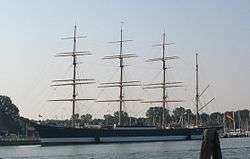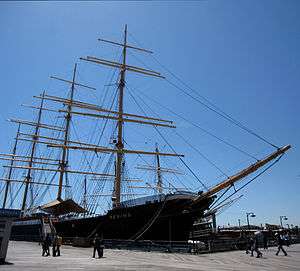Flying P-Liner

The Flying P-Liners were the sailing ships of the German shipping company F. Laeisz of Hamburg.
History
The company was founded in 1824 by Ferdinand Laeisz as a hat manufacturing company. He was quite successful and distributed his hats even in South America. In 1839, he had the three-masted wooden brig Carl (named after his son) built and entered the shipping business, but lack of success made him sell the ship a short five years later.
Ferdinand's son Carl Laeisz entered the business in 1852. It was he who turned the F. Laeisz company into a shipping business. In 1857, they ordered a barque which they named Pudel (which was the nickname of Carl's wife Sophie), and from the mid-1880s on, all their ships had names starting with "P" and they became known as "the P-line". The last ship without a "P-name" was the wooden barque Henriette Behn which was stranded on the Mexican coast in 1885.
The Laeisz company specialized in the South American nitrate trade. Their ships were built for speed, and they soon acquired an excellent reputation for timeliness and reliability, which gave rise to the nickname "the Flying P-Line". The five-masted barque Potosi made the voyage from Chile to England around Cape Horn in 1904 in just 57 days, which was a record at the time.
The Laeisz company had some of the largest sailing ships ever built. They experimented with steel-hulled five-masters, first the barque Potosi (1895) and in 1902 the huge full rigged ship Preussen with a length of 147 m, 5.081 GRT, and over 7.800 tons dead weight. She could sail faster than 18 knots and her best 24-hour distance was 392 sm in 1908 on her voyage to Yokohama. However, these ships turned out to be too big: their crews didn't like them, and it became increasingly difficult to achieve a satisfactory utilization on the outbound leg from Europe to Chile. The later ships, such as the Peking or the Passat, returned to being smaller four-masted barques.
During World War I, many of Laeisz' ships were blocked in Chilean ports and had to be handed over as war reparations. However, the Laeisz company was able to re-acquire many ships after the war and put them into service again.
Towards the end of the 1920s, the company began pulling out of the nitrate trade and increasingly started transporting other goods, e.g. bananas. They also sold some of their older ships, for instance the Pamir to Gustav Erikson in Finland who already had acquired the former Norddeutscher Lloyd-ship Herzogin Cecilie. The last sailing ship ordered by the Laeisz company was the Padua in 1926. Subsequently, the Laeisz company only ordered steam ships.
Ships

_and_the_'Penang'_(right)%2C_view_from_the_'Parma'.jpg)
Four of the Flying P-Liners still exist today:
- the Pommern is a museum ship in Mariehamn, Finland.
- the Peking is a museum ship in New York City (South Street Seaport).
- the Passat is a museum ship in Lübeck's sea resort Travemünde, Germany.
- the Padua is the only ship still active: she is today a school ship and sails as the Kruzenshtern under Russian flag.
Other famous Flying P-Liners were the five-masters
- Potosi, built 1895, sold 1923, caught fire and sunk off Argentina in 1925
- Preussen II, built 1902, beached in 1910 after being rammed by a steamer
and of course the four-masted barques
- Pamir, built 1905, capsized and sunk in 1957, 80 died, 6 rescued.
- Pisagua, built 1892, stranded 1912 South Shetlands
- Placilla, built 1892, stranded in Norfolk 1905
- Ponape, built 1903 in Italy, scrapped 1936
- Priwall, built 1917, burnt 1945 while loading in Valparaiso
- Parma, built 1902, after an accident in 1936 was scrapped in 1938
Other P-Line ships were:
- Pudel, built 1857, sunk 1870
- Palmyra, steel full-rigged ship built in 1889 by Blohm & Voss, Hamburg. Stranded on the Wellington Islands on the South Chilean coast 1908 July 2. The Captain and the first mate were able to reach shore but the rest of the crew of 21 men disappeared in one of the lifeboats.[1]
- Pera, built 1890, torpedoed 1917
- Pitlochry, built 1894, sunk 1913 in the English Channel
- Preussen I, built 1902, sunk in South Atlantic 1909
- Pellworm, built 1902, sunk 1944
- Pangani, built 1903, sunk 1913
- Penang, built 1905, torpedoed 1940
The Laeisz shipping company still exists today, operating many freighters under traditional names.
See also
References
External links
- Homepage of the F. Laeisz shipping company today.
- Krusenshtern ex Padua